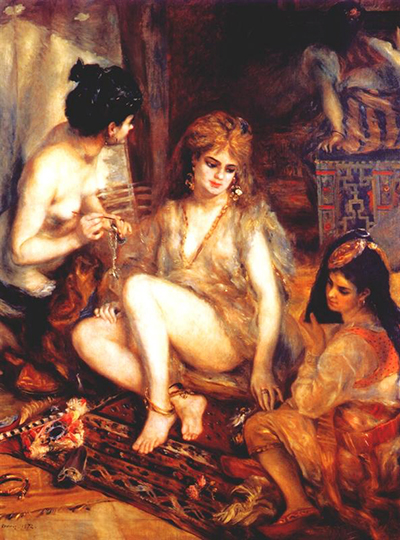Parisian Women Dressed in Algerian costumes, also known as Interior of a Harem in Montmartre, or the The Harem”in short, is a famous 1872 painting by Pierre-Auguste Renoir
Auguste Renoir (1841 –1919) was a doyen of his era, a leading and hugely successful painter, noted for his contributions to developing the Impressionist style of painting. He is well known for celebrating beauty in his works, and depicts feminine sensuality vividly.
The Harem Parisian Women Dressed as Algerians was composed at an interesting phase of Renoir’s life. Renoir was initially an adherent of realism, as propounded by masters such as Gustave Courbet and Edouard Manet.
However, in the 1970s, he shunned realism, and took inspiration from Eugène Delacroix. “The Harem” was painted as a homage to Delacroix’s famous 1834 work Women of Algiers in their Apartment. “The Harem” is one of the finest emulations of Delacroix's style, marked with colour and drama. Renoir describes “Women of Algiers in their Apartment” as “the most beautiful picture in existence.”
“The Harem Parisian Women Dressed as Algerians” abounds in artificialism. The title itself makes it explicit the “Harem” is not a realistic harem one would find in the Orient, but rather an artificial setting made up of Parisian women dressed up in Algerian costumes, creating a make-believe replica of a characteristic Algerian harem. The reference also drives home the fact Delacroix could not gain access to a harem during his visit to Algeria in 1832, and had to make do with a similar make-believe replica in Paris.
The central piece of the “Harem” is a blonde haired woman, depicted in the centre of the frame, and served by two black-haired women. The attendant women on the right hold up a mirror while the attendant women on the left apply makeup using a brush. The blonde is apparently being readied for a sexual encounter.
The figure in the top right corner is shown greeting a visitor. The arrival of the visitor seems to have caught the attention of the woman on the left as well, suggesting the visitor’s arrival being sudden and unexpected. Reinforcing this belief is the woman at the top having her hand raised up, apparently to delay access to the women being prepared for the sexual encounter.
Renoir's “The Harem Parisian Women Dressed as Algerians” however departs significantly from Delacroix's “Women of Algiers” in style. Delacroix arranged his harem figures across the foreground, whereas Renoir innovates with a diagonal layout. The subjects are arranged in a diagonal pattern.
An interesting feature is the picture plane being tipped towards the spectator, giving a feeling of the women about to slip down to the bottom of the picture. Again, while Delacroix’s figured were clothed, Renoir depicts nudity, which is so typical and commonplace is many of his works.
Critics have interpreted the scene to depict the arrival of a male client in a Paris brothel, set in an oriental theme.
There is a personal touch in the painting, as one of the models has been identified as Lise Tréhot, Renoir’s lover. Tréhot had sat for Renoir in many his works, and “the Harem” is, in fact, one of the last paintings for which she modelled for Renoir.
The brilliance of the painting notwithstanding, “The Harem” was not a commercial success at the time. It was rejected by the Paris Salon of 1872. The rejection ended Renoir’s infatuation with Orientalism. The original painting was eventually acquired by Hyacinthe-Eugène Meunier of Paris in 1912, and changed hands many times until it reached Japan. It is now in the National Museum of Western Art, Tokyo.




